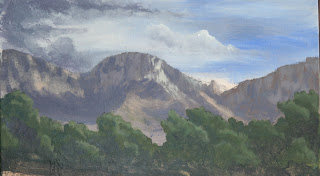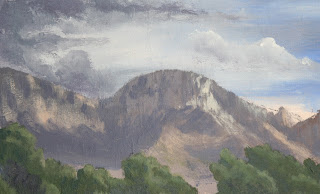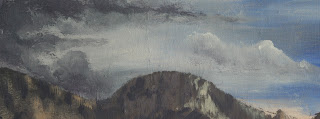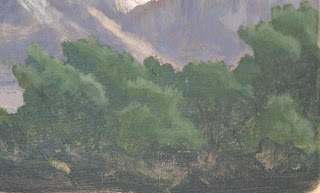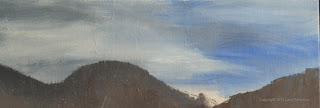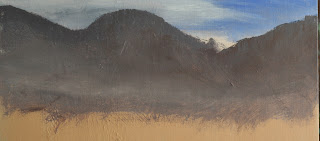SPRING
2013 ACRYLIC CLASS
Project:Az Wash
This
past week in class we did a couple of techniques to our study then we started
our project. The techniques we learned were how to do a wet and a dry glaze.
Both are very handy to know and can be used in a wide variety of situation.
The
dry brush glaze is great when you need to work in smaller areas or add areas of
haze or mist. It is great for fog, smoke, dust anything that might be in the
air that is soft and hazy, even clouds are made with this technique. The key is
a brush that is just damp – you shouldn’t be able to squeeze any water from it
- and very little paint.
After
you rinse your brush squeeze it in your paper towel until it is mostly dry. The
bristles will be damp but there should be no excess water in the brush. When
you load your brush with paint, work the color into the bristles then wipe the
excess off on your paper towel, the color should be mostly in the bristles
not on the bristles (no visible lumps). To apply the color (whatever
color you are using depending on your subject), using the small side of your
flat bristle brush, with very light pressure on the brush, go in small circles,
you should be able to see the color that is underneath this glaze, if you press
too hard or go over and over the same area, you will lose the under color, if
that is what you want to do fine but it is better to sneak up on it and stand
back often to see if you are getting the desired effect. Also, if you rub in
one place too long you run the risk of rubbing a hole in the paint, so a light
touch and keep moving.
The
other form a glazing is a wet glaze. This is a technique that you use over a
larger, broader area usually. It can instantly add distance to you painting by
adding a visual atmosphere to the areas you apply it to, you can also use a
variation of this technique to add a shimmer to still water again, it is a good
thing to know and practice.
You
usually will need your wide blending or hake brush for this technique because
you will want to cover the area quickly and evenly this brush works great for
doing just that sort of thing. The color may vary depending on what you are
trying to accomplish but it usually includes a bit of gesso (gesso as oppose to
regular white because it is on the opaque side which you will need in most
cases) and some color. If you want it warm you use the warm colors of the
palette (I’m talking visual heat such as reds, yellows and oranges) or if you want
to cool it down use the cool side of the palette (blues, purples, some greens)
this color is totally dependent on what you need it to do. To this color you
will add A LOT OF WATER. I don’t usually tell you to add a ton of water on the
contrary I tell you to be careful not to add too much water to your paint but
for this technique to work correctly the color needs to be thinned down so that
when you apply it, it is more a haze of color so you can see what is
underneath. Keep this in mind though when you are loading your brush, you don’t
want it to be dripping off your brush so soak up any excess with your paper
towel and if you get runs on your canvas, quickly clean them off with a wet
paper towel and smooth out the color in the area so it looks evenly applied.
This will be kinda scary because when it is wet it looks very thick but as it
dries it will be just a haze of color if you did it correctly, which is why we
practice.
You
can also use this technique to tint all or part of your painting. I sometimes
will want to warm the entire painting up and will use a very diluted color
(quinacridone gold) and go over my entire painting with this color (no gesso).
You can also “antique” a painting with umber same thing and lightly wiping.
Please practice this before you try it on your “masterpiece” so you know just
how much you need to do.
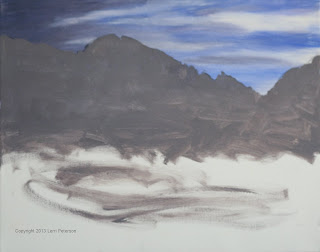 |
| Start of the Az Wash project |
This
is where we started the actual project, since I have already gone over those
techniques I’m not going to type them out again, just go back to the earlier
posts for the sky and the mountains, the same things applies to the actual
project so use the posts as a review. See you in class.
